microsoft AZ-120 Exam Questions
Questions for the AZ-120 were updated on : Jun 27 ,2025
Page 1 out of 8. Viewing questions 1-15 out of 118
Question 1 Topic 1, Case Study 1Case Study Question View Case
HOTSPOT
You are evaluating the proposed backup policy.
For each of the following statements, select Yes if the statement is true. otherwise, select No.
NOTE: Each correct selection is worth one point.
Hot Area: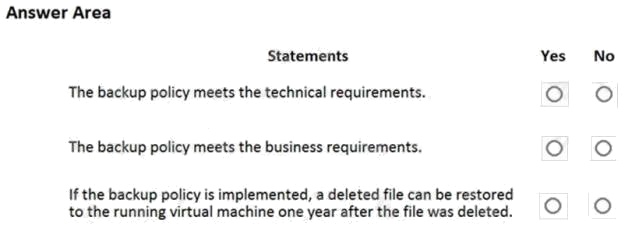
Answer:
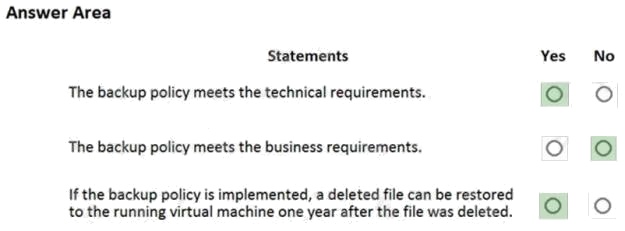
Explanation:
Box 1: Yes
Scenario: Technical requirements: Ensure that an application server can be restored from a backup created during the last
five days within 15 minutes.
Instant Restore has 'The instance recovery snapshot(s) for 5 Day(s)'.
Box 2: No
Scenario: Ensure that all the production application servers can restore daily backups from the last 21 days.
The Retention of daily backup point is set to for 14 days only.
Box 3: Yes
Reference: https://docs.microsoft.com/en-us/azure/backup/backup-instant-restore-capability
Question 2 Topic 1, Case Study 1Case Study Question View Case
HOTSPOT
You are planning replication of the SAP HANA database for the disaster recovery environment in Azure.
For each of the following statements, select Yes if the statement is true. Otherwise, select No.
NOTE: Each correct selection is worth one point.
Hot Area: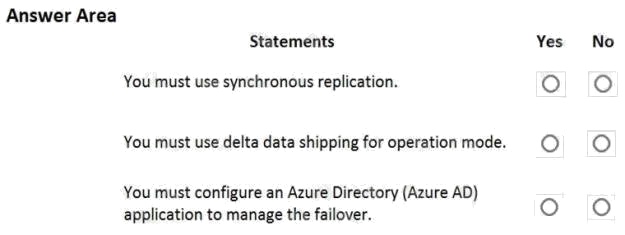
Answer:
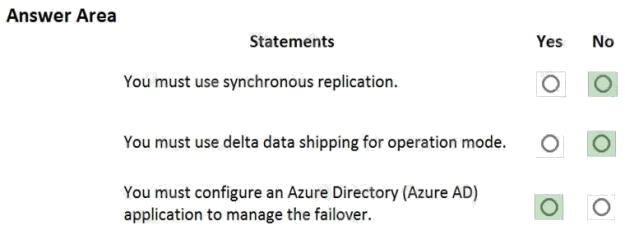
Explanation:
Box 1: No
SAP HANA Replication consists of one primary node and at least one secondary node. Changes to the data on the primary
node are replicated to the secondary node synchronously or asynchronously.
Box 2: No
Since SPS11 SAP HANA system replication can be run in two different operation modes: delta_datashipping logreplay Box
3: Yes
Reference: https://docs.microsoft.com/en-us/azure/virtual-machines/workloads/sap/sap-hana-high-availability-rhel
https://blogs.sap.com/2018/01/08/your-sap-on-azure-part-4-high-availability-for-sap-hana-using-system-replication/ Migrate
SAP Workloads to Azure
Question 3 Topic 1, Case Study 1Case Study Question View Case
HOTSPOT
You are evaluating the proposed backup policy.
For each of the following statements, select Yes if the statement is true. Otherwise, select No.
NOTE: Each correct selection is worth one point.
Hot Area: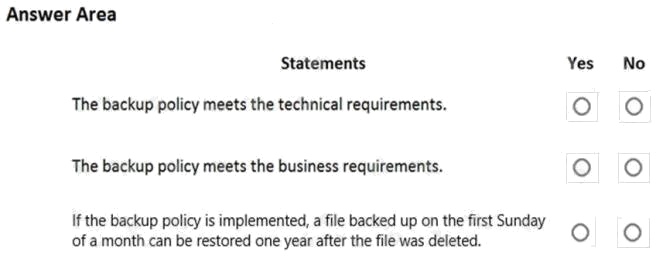
Answer:
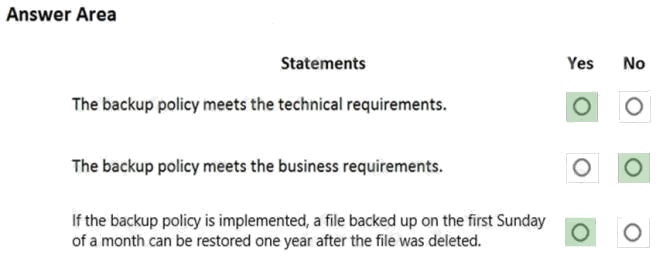
Explanation:
Box 1: Yes
Scenario: Technical requirements: Ensure that an application server can be restored from a backup created during the last
five days within 15 minutes.
Instant Restore has 'The instance recovery snapshot(s) for 5 Day(s)'.
Box 2: No
Scenario: Ensure that all the production application servers can restore daily backups from the last 21 days.
The Retention of daily backup point is set to for 14 days only.
Box 3: Yes
Yes, the early backups are retained for 7 years.
Reference:
https://docs.microsoft.com/en-us/azure/backup/backup-instant-restore-capability
Question 4 Topic 2, Case Study 2Case Study Question View Case
You need to ensure that you can receive technical support to meet the technical requirements.
What should you deploy to Azure?
- A. SAP Landscape Management (LaMa)
- B. SAP Gateway
- C. SAP Web Dispatcher
- D. SAPRouter
Answer:
A
Explanation:
Scenario: Ensure that SAP can provide technical support for all the SAP landscapes deployed to Azure.
References: https://blogs.sap.com/2019/07/22/sap-landscape-management-on-microsoft-azure-part-1/
Question 5 Topic 2, Case Study 2Case Study Question View Case
HOTSPOT
For each of the following statements, select Yes if the statement is true. Otherwise, select No.
NOTE: Each correct selection is worth one point.
Hot Area: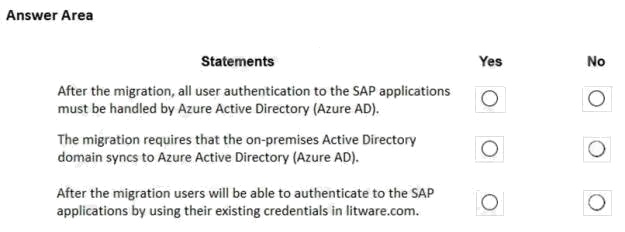
Answer:
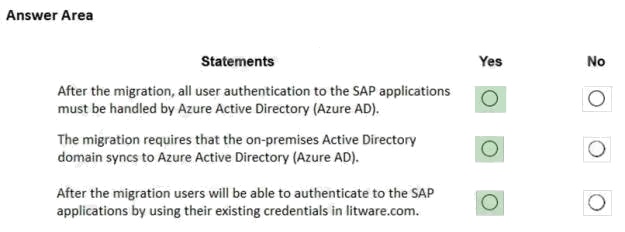
Explanation:
In a Hybrid-IT scenario, Active Directory from on-premises can be extended to serve as the authentication mechanism
through an Azure deployed domain controller (as well as potentially using the integrated DNS).
It is important to distinguish between traditional Active Directory Servers and Microsoft Azure Active Directory that provides
only a subset of the traditional on-premises AD offering. This subset include Identity and Access Management, but does not
have the full AD schema or services that many 3rd party application take advantage of. While Azure Active Directory IS a
requirement to establish authentication for the Azure virtual machines in use, and it can synchronize users with customers
on-premises AD, the two are explicitly different and customers will likely continue to require full Active Directory servers
deployed in Microsoft Azure.
References: https://www.suse.com/media/guide/sap_hana_on_azure_101.pdf
Question 6 Topic 2, Case Study 2Case Study Question View Case
You need to recommend a solution to reduce the cost of the SAP non-production landscapes after the migration.
What should you include in the recommendation?
- A. Configure scaling of Azure App Service
- B. Migrate the SQL Server databases to Azure SQL Data Warehouse
- C. Deallocate virtual machines when not in use
- D. Deploy non-production landscapes to Azure DevTest Labs
Answer:
D
Explanation:
Relevant use cases Dev/test environments for SAP workloads on Azure.
Noncritical SAP nonproduction workloads (such sandbox, development, test, and quality assurance). Noncritical SAP
business workloads.
References: https://docs.microsoft.com/en-us/azure/architecture/example-scenario/apps/sap-dev-test
Question 7 Topic 3, Case Study 3Case Study Question View Case
This question requires that you evaluate the underlined text to determine if it is correct.
You are planning for the administration of resources in Azure.
To meet the technical requirements, you must first implement Active Directory Federation Services (AD FS).
Instructions: Review the underlined text. If it makes the statement correct, select No change is needed. If the statement is
incorrect, select the answer choice that makes the statement correct.
- A. No change is needed
- B. Azure AD Connect
- C. Azure AD join
- D. Enterprise State Roaming
Answer:
A
Explanation:
The SAP Cloud Platform Identity Authentication and Active Directory Federation Services enable you to implement SSO
across applications or services that are protected by Azure AD (as an IdP) with SAP applications and services that are
protected by SAP Cloud Platform Identity Authentication.
Scenario: Use Active Directory accounts to administer Azure resources.
Incorrect Answers:
Not D: With Windows 10, Azure Active Directory (Azure AD) users gain the ability to securely synchronize their user settings
and application settings data to the cloud. Enterprise State Roaming provides users with a unified experience across their
Windows devices and reduces the time needed for configuring a new device. Enterprise State Roaming operates similar to
the standard consumer settings sync that was first introduced in Windows 8.
References: https://docs.microsoft.com/en-us/azure/active-directory/saas-apps/sap-hana-cloud-platform-identity-
authentication-tutorial
Question 8 Topic 3, Case Study 3Case Study Question View Case
HOTSPOT
Before putting the SAP environment on Azure into production, which command should you run to ensure that the virtual
machine disks meet the business requirements? To answer, select the appropriate options in the answer area.
NOTE: Each correct selection is worth one point.
Hot Area:
Answer:

Explanation:
Scenario: Ensure that all the production databases can withstand the failure of an Azure region.
References: https://docs.microsoft.com/en-us/powershell/module/az.compute/get-azvmimage
Question 9 Topic 3, Case Study 3Case Study Question View Case
HOTSPOT
You need to provide the Azure administrator with the values to complete the Azure Resource Manager template.
Which values should you provide for diskCount, StorageAccountType, and domainName? To answer, select the appropriate
options in the answer area.
NOTE: Each correct selection is worth one point.
Hot Area: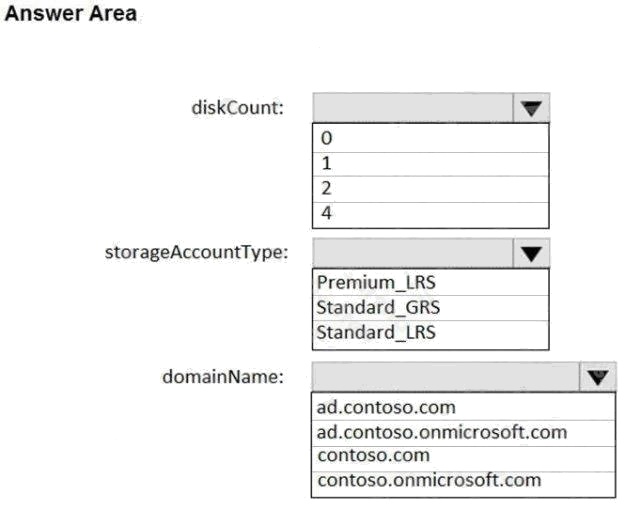
Answer:
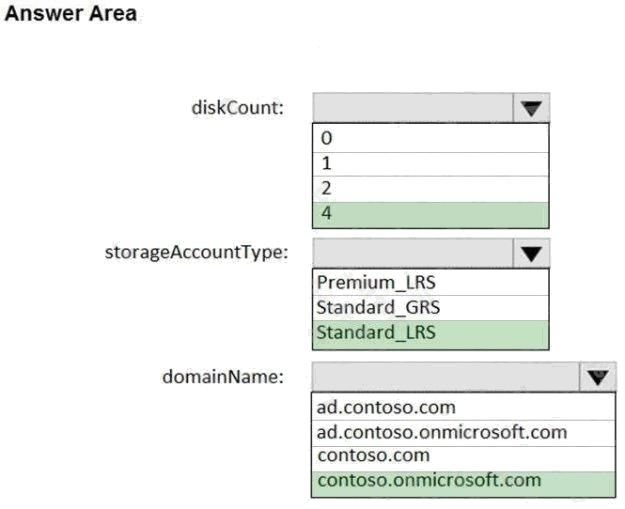
Explanation:
Box 1: 4
Scenario: the Azure Resource Manager template that will be used to provision the production application servers. Ensure
that each production application server has four 1-TB data disks.
Box 2: Standard_LRS
Scenario: Minimize costs whenever possible.
Box 3: contoso.onmicrosoft.com
The network contains an on-premises Active Directory domain named ad.contoso.com.
The Initial domain: The default domain (onmicrosoft.com) in the Azure AD Tenant. For example, contoso.onmicrosoft.com.
References:
https://docs.microsoft.com/en-us/azure/active-directory/hybrid/plan-connect-userprincipalname
Build and Deploy Azure SAP Workloads
Question 10 Topic 4, Case Study 4Case Study Question View Case
Once the migration completes, to which size should you set the ExpressRoute circuit to the New York office to meet the
business goals and technical requirements?
- A. 500 Mbps
- B. 1,000 Mbps
- C. 2,000 Mbps
- D. 5,000 Mbps
Answer:
C
Explanation:
ExpressRoute circuits are configured to allow you to burst up to two times the bandwidth limit you procured for no additional
cost.
Scenario: It is estimated that during the migration, the bandwidth required between Azure and the New York office will be 1
Gbps. After the migration, a traffic burst of up to 3 Gbps will occur.
Reference: https://docs.microsoft.com/en-us/azure/expressroute/expressroute-faqs
Question 11 Topic 4, Case Study 4Case Study Question View Case
You are planning the Azure network infrastructure to support the disaster recovery requirements.
What is the minimum number of virtual networks required for the SAP deployment?
- A. 1
- B. 2
- C. 3
- D. 4
Answer:
B
Explanation:
Scenario: Ensure that all the production databases can withstand the failure of an Azure region.
Note: Use Azure Site Recovery to replicate applications across regions. Azure Site Recovery replicates workloads running
on physical and virtual machines from a primary site (either on-premises or in Azure) to a secondary location (in Azure).
When an outage occurs at the customer's primary site, a failover can be triggered to quickly return the customer to an
operational state. After the primary location is restored, customers can then fail back.
Reference:
https://docs.microsoft.com/en-us/azure/architecture/resiliency/recovery-loss-azure-region
Question 12 Topic 5, Mixed Questions
You are evaluating which migration method Litware can implement based on the current environment and the business
goals.
Which migration method will cause the least amount of downtime?
- A. Migrate SAP ECC to SAP Business Suite in HANA, and then migrate SAP to Azure.
- B. Use Near-Zero Downtime (NZDT) to migrate to SAP HANA and Azure during the same maintenance window.
- C. Use the Database Migration Option (DMO) to migrate to SAP HANA and Azure during the same maintenance window.
- D. Migrate SAP to Azure, and then migrate SAP ECC to SAP Business Suite on HANA.
Answer:
C
Explanation:
The SAP Database Migration Option (DMO) with System Move option of SUM, used as part of the migration allows customer
the options to perform the migration in a single step, from source system onpremises, or to the target system residing in
Microsoft Azure, minimizing overall downtime.
Reference: https://blogs.sap.com/2017/10/05/your-sap-on-azure-part-2-dmo-with-system-move/
Question 13 Topic 5, Mixed Questions
You are migrating SAP to Azure. The ASCS application servers are in one Azure zone, and the SAP database server in in a
different Azure zone. ASCS/ERS is configured for high availability.
During performance testing, you discover increased response times in Azure, even though the Azure environment has better
computer and memory configurations than the on-premises environment.
During the initial analysis, you discover an increased wait time for Enqueue.
What are three possible causes of the increased wait time? Each correct answer presents a complete solution.
NOTE: Each correct selection is worth one point.
- A. a missing Enqueue profile
- B. disk I/O during Enqueue backup operations
- C. misconfigured load balancer rules and health check probes for Enqueue and ASCS
- D. active Enqueue replication
- E. network latency between the database server and the SAP application servers
Answer:
C D E
Explanation:
E: The network latency across Availability Zones is not the same in all Azure regions. In some cases, you can deploy and
run the SAP application layer across different zones because the network latency from one zone to the active DBMS VM is
acceptable. But in some Azure regions, the latency between the active DBMS VM and the SAP application instance, when
deployed in different zones, might not be acceptable for SAP business processes.
References: https://docs.microsoft.com/en-us/azure/virtual-machines/workloads/sap/sap-ha-availability-zones
Question 14 Topic 5, Mixed Questions
You have an on-premises SAP environment that uses AIX servers and IBM DB2 as the database platform.
You plan to migrate SAP to Azure. In Azure, the SAP workloads will use Windows Server and Microsoft SQL Server as the
database platform.
What should you use to export from DB2 and import the data to SQL Server?
- A. R3load
- B. Azure SQL Data Warehouse
- C. SQL Server Management Studio (SSMS)
- D. R3trans
Answer:
C
Explanation:
To migrate DB2 databases to SQL Server, you must connect to the DB2 database that you want to migrate. When you
connect, SSMA obtains metadata about all DB2 schemas, and then displays it in the DB2 Metadata Explorer pane.
References: https://docs.microsoft.com/en-us/sql/ssma/db2/connecting-to-db2-database-db2tosql?view=sql-server-ver15
https://docs.microsoft.com/en-us/biztalk/adapters-and-accelerators/adapter-sap/import-sap-data-using-sql-server-
management-studio
Question 15 Topic 5, Mixed Questions
HOTSPOT
You are designing the backup for an SAP database.
You have an Azure Storage account that is configured as shown in the following exhibit.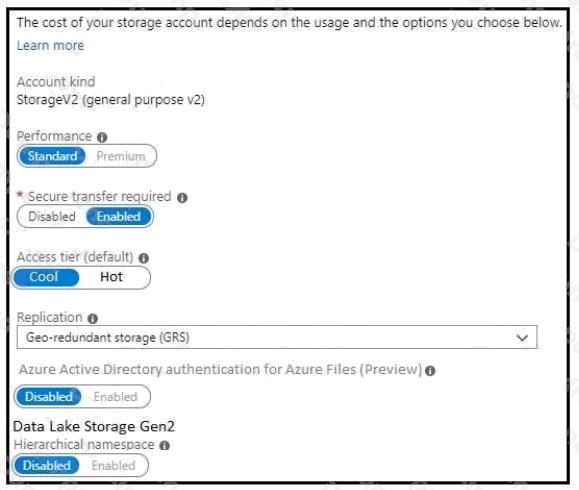
Use the drop-down menus to select the answer choice that completes each statement based on the information presented in
the graphic.
NOTE: Each correct selection is worth one point.
Hot Area: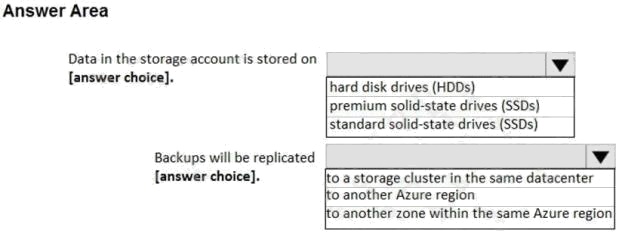
Answer:
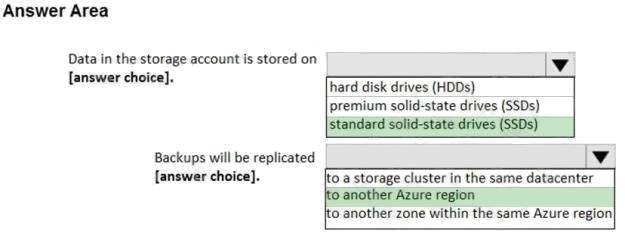
Explanation:
Box 1: standard solid-state drives (SSDs)
Standard SSD Managed Disks, a low-cost SSD offering, are optimized for test and entry-level production workloads requiring
consistent latency.
Box 2: to another Azure region
Geo-redundant storage (GRS) copies your data synchronously three times within a single physical location in the primary
region using LRS. It then copies your data asynchronously to a single physical location in a secondary region that is
hundreds of miles away from the primary region.
References: https://azure.microsoft.com/en-us/pricing/details/managed-disks/ https://docs.microsoft.com/en-
us/azure/storage/common/storage-redundancy#geo-redundant-storage